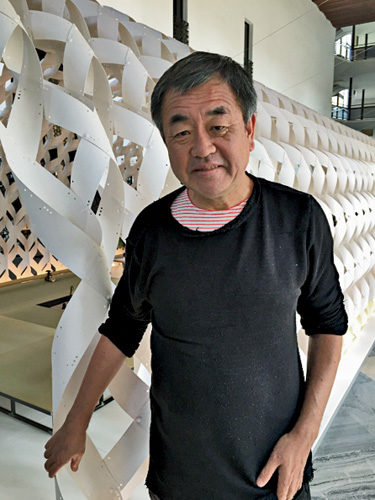With Milan's rich history in architecture, art, and design, it is inevitable that its illustrious past will be drawn on by the annual Salone del Mobile. This year in particular, despite Milan also serving as host of the futuristic Expo 2015, the past took center stage at the furniture fair, with old palazzi and churches as backdrops for the most interesting exhibits, and reissues of classic designs stealing the spotlight from new product introductions, which were fewer and less interesting than usual.
The Italian magazine Interni typically engages international architects and designers for temporary exhibits that become spaces for experimentation during the Salone. Working off the “energy for life” theme of the nearby Expo 2015, this year Interni presented Energy for Creativity at the University of Milan. Within the many courtyards of the sprawling university complex, built starting in 1456 as a hospital, were large-scale installations by such luminaries as Daniel Libeskind, Alessandro Mendini, and Philippe Starck.
Libeskind, who has a large office in Milan, is a regular participant in the Salone. “This week in Milan is a chance to look at architecture and design in a free way,” he says. “No city in the world has this type of event that's open to the public.” His installation, a celebration of color and straight lines, was set within what's known as the Pharmacy Courtyard. The low, crisscrossing metal panels were painted in a red the architect developed for Italian paint manufacturer Oikos. According to Libeskind, “We created a palette of 33 colors with a unique, solvent-free, and sustainable chemistry.”
Tokyo and Paris–based architect Kengo Kuma also has an annual presence here. He was invited by Japanese kitchen manufacturer Kitchenhouse, for whom he designed a Shanghai showroom, to create an exhibit outside the university's grand hall. Inspired by the traditional Japanese hearth, or irori, Kuma made what he refers to as “fire and cocoon.” “The fireplace used to be the center of the home,” Kuma explains. “In the 20th century, rooms got divided in an unhealthy way. I want to combine the traditional and the new in an open space.”
Made from 1 millimeter-thick vulcanized paper, Kuma's cocoon of twisting and weaving strips was developed on the computer but built by hand. The long, white, cloudlike structure, which supports itself, encases a space where a low platform with a fire pit, kitchen, and dining area flow into each other.
Exhibiting for the first time in Milan, New York–based architects Steve Blatz and Antonio Pio Saracino created Black Hole. Composed of steel, glass, and wood (provided by sponsors Marzorati Ronchetti, Vetreria Bazzanese, and Zordan), the small tower is meant to be a “creative balance of chaos and order,” according to Blatz. Within the perfectly round form, visitors could recline on the circular wood seating at the base to gaze up through the oculus, composed of irregularly shaped overlapping wood discs.
Not far from the university complex, surfaces manufacturer Caesarstone exhibited inside the Neoclassical Palazzo Serbelloni. Its grand hall housed an interactive installation by Canadian-born designer Philippe Malouin, where the flooring and seats of an eight-piece swing set showcased newly launched designs and textures from Caesarstone's collection.
South of the city center, CLS Architetti, led by Massimiliano Locatelli, opened its new office to the public for the week. The unusual workspace, inside the deconsecrated church of San Paolo Converso, also had on display recent designs by Locatelli, including a table for Glas Italia made entirely of glass, including the legs.
While leading furniture manufacturer Kartell exhibited new products, including, curiously, a fragrance line, at the fairgrounds, it used its flagship showroom in the city to host a tribute to Memphis, the 1980s design group founded by the late Italian architect Ettore Sottsass. A collection of vases, stools, and a lamp designed for the company by Sottsass in 2004—some now being put into production for the first time—were shown within a vibrant display of objects and fabrics typical of Memphis's postmodern aesthetic.
Elsewhere, Veneto-based Italamp showcased new LED chandeliers designed by Marco Piva, called Crowns, using 1,000-year-old methods of Venetian glass- making. Meanwhile, Molteni&C celebrated its 80th anniversary with new furniture designs by the likes of HOK and Foster + Partners, as well as reissues of classic Gio Ponti designs. Knoll, too, honored Harry Bertoia with a new polypropylene version of his iconic metal side chair on the centennial of the designer's birth.














Post a comment to this article
Report Abusive Comment